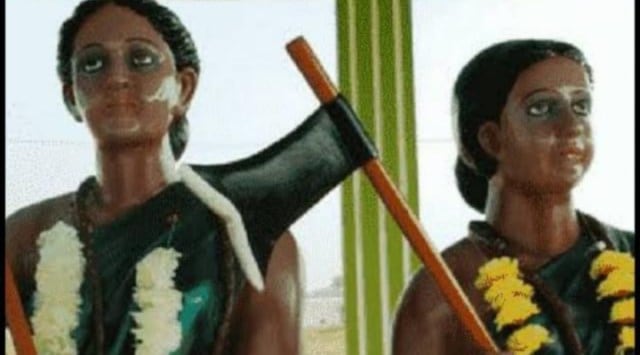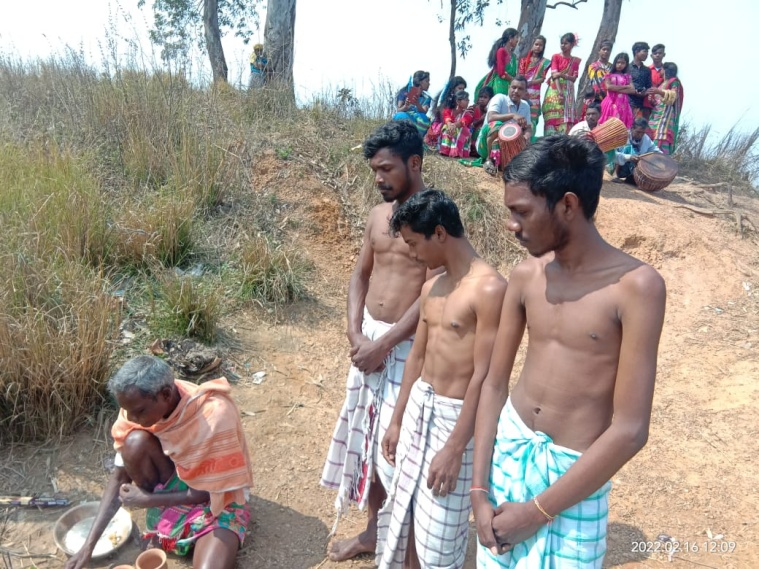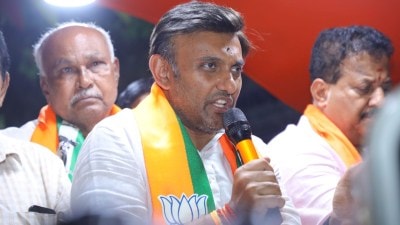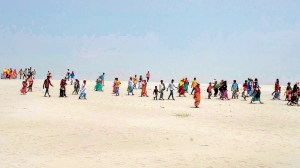- India
- International
Santal Hul: Remembering Santal women who fought for indigenous rights two centuries ago
The Santal Hul was among one of the important tribal revolts that continues to hold immense significance for the Santal community.
 Statues of Phulo Murmu and Jhano Murmu in Bansol village, Birbhum, India. Phulo and Jhano Murmu were two women leaders during the Santal Hul, and have been credited for inspiring and gathering other women to revolt. They used to campaign against the British through songs, stories etc. Photo credit: Rabin Soren
Statues of Phulo Murmu and Jhano Murmu in Bansol village, Birbhum, India. Phulo and Jhano Murmu were two women leaders during the Santal Hul, and have been credited for inspiring and gathering other women to revolt. They used to campaign against the British through songs, stories etc. Photo credit: Rabin SorenSome two centuries after Santal Hul, community-level organisations in West Bengal come together every year to mark the revolution of 1855-1856 on June 30.
Historians often consider the Sepoy Mutiny—Indian Rebellion or Uprising—of 1857 as the first war of Independence against colonial rule in the Indian subcontinent, but scholars of indigenous history believe that this narrative dismisses the occurrence of several tribal revolts that preceded this war. The Santal Hul was among one of the important tribal revolts that continues to hold immense significance for the Santal community.
 A priest in the Santal community conducts rituals in remembrance of the Santal Hul in Birbhum, West Bengal. Photo credit: Rabin Saren
A priest in the Santal community conducts rituals in remembrance of the Santal Hul in Birbhum, West Bengal. Photo credit: Rabin Saren
Rahi Soren, Assistant Professor at Jadavpur University, told indianexpress.com that the rebellion was a result of decades of injustice that Santals and peasants found themselves facing at the hands of exploitative zamindars (landlords), mahajans (moneylenders), traders, and administrative officials appointed by the British Raj, as well as security forces that bore allegiance to the East India Company.
Exploitation, abuse, and violation
It was Damin-i-Koh, the forested hilly areas of the Rajmahal hills, that sparked what came to be known as the Santal Hul. In the late 1700s, Santals settled in the area that is now known as Santhal Parganas, in present-day Jharkhand, after being forced to migrate by zamindars of Birbhum. Soon after they settled here, tax-collecting intermediaries, acting on behalf of the British, began targeting the Santals, forcing corrupt money-lending practices onto the community. “Damin-i-Koh was a result of people who were not agricultural who were forced to be agricultural. It was forced labour, forced money-lending. It was pent-up anguish and frustration over a century,” said Soren.

 Hul Diwas on June 30 will be marked by the Paschim Banga Adibasi Gaota in Bansol village, Birbhum, India. Photo credit: Rabin Soren
Hul Diwas on June 30 will be marked by the Paschim Banga Adibasi Gaota in Bansol village, Birbhum, India. Photo credit: Rabin Soren
The exploitation, abuse, and violation that the Santals were subjected to at the hands of the British and their intermediaries find mention in the writings of British administrative officials living and working in the area at that time. One of those accounts can be found in W W Hunter’s The Annals of Rural Bengal. “In the administration of the Santhal settlement, everything that cost money without bringing in a tangible return was avoided….The superintendent was pre-eminently a practical man; and so it fell out that, early in 1855 the most peaceful province in the empire became the scene of a protracted rebellion, without anyone being able to give either warning or explanation. Many Santhals had no land or crop to pledge for their little debts. If a man of this class required a few shillings to bury his father, he went to the Hindu usurer for it; having (no) security to offer except his manual labour and that of his children…he bound over himself and family as slaves till the loan (was repaid),” writes Hunter.
There were several kinds of exploitative practices that the money-lenders and traders engaged in, that prominently feature in the stories that members of the community narrate about the Hul. “Generations of people could not get out of money-lending,” said Soren.
 A 2021 photograph of Hul Diwas commemorations in Birbhum, India. Photo credit: Rabin Soren
A 2021 photograph of Hul Diwas commemorations in Birbhum, India. Photo credit: Rabin Soren
Rabin Soren, secretary of the Paschim Banga Adibasi Gaota, Birbhum, pointed to one particular practise where traders in marketplaces would cheat Santals by using heavier weights when buying grains or other items from them and lighter weights when Santals made purchases. “They would do it because they thought that Santals were simple people and lacked formal education,” he said.
Tale of Phulo Murmu and Jhano Murmu
Written records about the Santal Hul, except a few by survivors of the rebellion, are scarce in part because, in the Santal community, language and knowledge are imparted through oral education, passed down from elders in the family. But the stories of the Hul talk extensively about how four brothers, Santal leaders Sidho Murmu, Kano Murmu, Chand Murmu, and Bhairab Murmu mobilised some 10,000 people on June 30, 1855, against the British and their intermediaries—a landmark event in Santal history and in that of the subcontinent’s fight for independence from colonial rule.
As usual, narratives of the Santal Hul often focus on the men who led the revolt without taking into account the important roles that Santal women played in it. It should not come as a surprise that women did play a role in the Hul, said Soren of Jadavpur University. “It is a patriarchal society, but there is comparatively lesser gender discrimination in the Santal community. But mobility was never an issue. So when the uprising happened, men and women were shoulder to shoulder. (But) women are celebrated less,” she added.
Conscious of how the narratives around the Hul tend to focus on the men leaders of the revolt, four years ago, a community-level organisation was set up in West Bengal’s Paschim Bardhaman. Located approximately 5 km from Durgapur, in Bansol village, the Fulo Jhano Trust is named after two women leaders, Phulo Murmu and Jhano Murmu, sisters belonging to the same Murmu family of Sidho, Kano, and others, who participated in the Hul.
“Phulo Murmu and Jhano Murmu were responsible for inspiring and gathering other women to revolt. They used to campaign against the British through songs, stories etc. Women have been largely invisible in the narrative and only now we have started giving them recognition for their contributions,” said Shib Shankar Hansda, a Bengali language teacher at the government-run Pansuli High School in Bansol.
‘Every Santal woman was a rebel’
In his 2017 paper Santal Women and the Rebellion of 1855 in Colonial India, Dr Ata Mallick points to judicial records of the rebellion that indicate that “almost every Santal woman was a rebel and many of them were arrested for their active involvement in the rebellion”.
But these records also show that most were released following trial on grounds that they were not guilty. There appears to be some division among scholars of the Hul on the veracity of these claims, specifically the number of women who actively participated.
Mallick’s paper mentions that Santal women also took on combative roles during the Hul, standing shoulder to shoulder along with the men who fought against the British. “According to these administrative reports, it seems that Santal women were active participants of the rebellion, and on some occasions, they were more prominent than men,” writes Mallick.
But Mallick also points to the memoirs of Chotrae Deshmanjhi, a Santal participant of the Hul from Birbhum, that disputes these claims of the British administrative records, and does not mention that women took “imperative roles in the field of action”.
However, change is coming through on ground, with more people in the community bringing attention to the roles Santal women played during the revolution of 1855-1856, through community-level organisations spread across West Bengal and Jharkhand.
On Hul Diwas on June 30, the Paschim Banga Adibasi Gaota, one among a handful of these organisations, will host a gathering of the Santal community in Bansol village.
“We will talk about Phulo and Jhano, as well as the men who led the revolt. We will talk about how despite the lack of formal education back during the Hul, women came out and fought alongside men. We will also discuss why the women don’t come out and speak and now remain within the confines of the home. (Santal) women don’t speak about administrative affairs or in other aspects of everyday life,” said Hansda.
Apr 27: Latest News
- 01
- 02
- 03
- 04
- 05








































